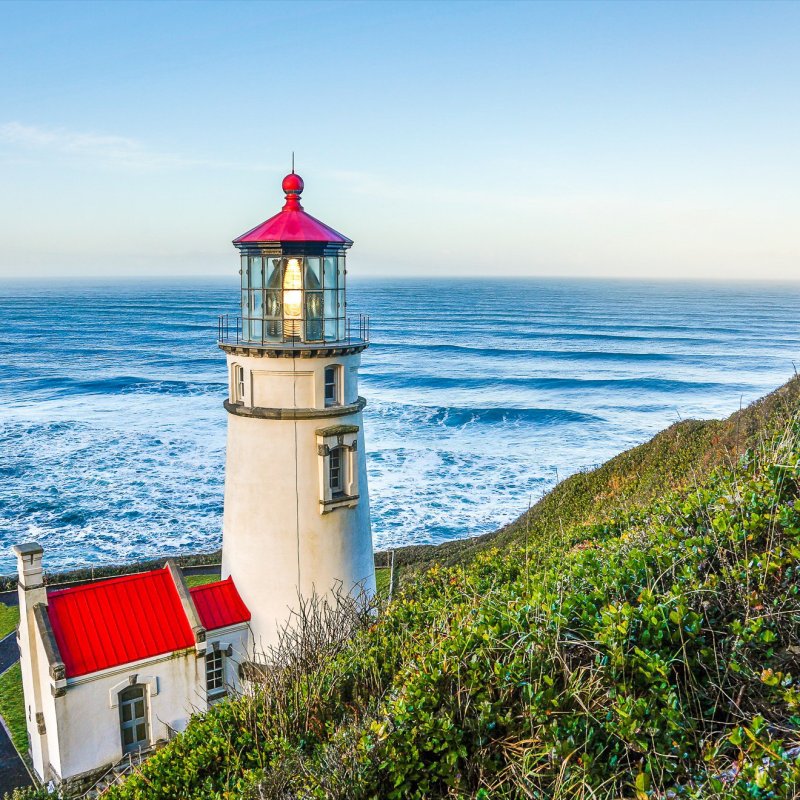
Despite the existence of newer forms of navigation technology, more than a few lighthouses are still being used to help ships sail through narrow channels and around rocky reefs. Most of these lighthouses have weathered storms and years of disrepair, but all have become beloved landmarks in their communities, and now people from all over the world travel to see them. These lighthouses are beautiful reminders of the past, of centuries of maritime history, and of the fact that there is always hope, even in the darkest of times.
Videos by TravelAwaits
Here are 10 of the remarkable lighthouses that are still in operation in the United States.

1. West Point Lighthouse, Seattle, Washington
Located in Discovery Park, West Point Lighthouse is one of the most popular attractions on the coast of Puget Sound. The lighthouse opened in the fall of 1881 to guide ships through Seattle’s Elliott Bay. Uniquely, this lighthouse’s beacon alternates between red and white every 5 seconds.
Although the lighthouse itself is only 23 feet tall, the beauty of the land on which it is located is breathtaking. During the spring, the lighthouse is surrounded by tall grass that fills with wildflowers, and Mount Rainier’s snowy peak looms behind the structure. The gorgeous views make this one of the most beautiful active lighthouses.

2. Heceta Head Lighthouse, Florence, Oregon
Lit for the first time in the spring of 1894, Heceta Head Lighthouse is located on the coast of Oregon between Coos Bay and Newport.
Perched on a scenic cliffside, the lighthouse shines from 205 feet above sea level and can be seen 21 miles from the shore. Both the lighthouse and keeper’s home were built in the elaborate Queen Anne style that was popular during the 1880s and 1890s.
The lighthouse was electrified in 1930 and fully automated by 1963, eliminating the need for a lighthouse keeper. The keeper’s home served as a Coast Guard bunker during World War II and afterward as a classroom for college students. It is now a beautiful bed and breakfast.
The lighthouse and the keeper’s home are both on the National Register of Historic Places.

3. Pigeon Point Lighthouse, Pescadero, California
Work on Pigeon Point Lighthouse began after the ship Carrier Pigeon sank off the coast of California between San Francisco and Santa Cruz in 1853.
The lighthouse was completed 19 years later; it stands 115 feet tall and still assists boats in stormy weather. It’s tied with the Point Arena Lighthouse for the title of tallest lighthouse on the West Coast.
Although Pigeon Point Lighthouse initially used a first-order Fresnel lens, it’s now equipped with a Vega marine rotating beacon. The lighthouse is currently being renovated, but the original lens is available for viewing in the fog-signal building.
Teeming with wildlife, the area around Pigeon Point Lighthouse is stunning. During low tide, nearby tide pools reveal sea urchins, hermit crabs, and starfish. You might also see seals, sea lions, and migrating whales in the area.

4. Sturgeon Point Lighthouse, Harrisville, Michigan
Located between Alcona and Harrisville on Lake Huron, Sturgeon Point Lighthouse helps ships navigate around the nearby reef. Opened in 1870, it has been in operation ever since!
Although it’s located on one of the Great Lakes, the lighthouse was built in the Cape Cod style, an architectural style that originated in Massachusetts. The limestone foundation connects the keeper’s house to the 70-foot-tall tower; the two buildings are separated only by an iron door. The slanted roof and bright red accents on the shutters, doors, and roof make for an incredibly picturesque lighthouse.
The original light was a 3.5 Fresnel lens from Paris. Electricity came to Sturgeon Point in 1939, which led to the automation of the lighthouse a few years later. After the keeper’s departure, the house stood empty until it was turned into a maritime museum. Both the keeper’s house and the lighthouse are now open to visitors.

5. Toledo Harbor Lighthouse, Toledo, Ohio
Situated a few miles off of Ohio’s shore, Toledo Harbor Lighthouse guides ships through the waters of Lake Erie. This part of the channel was originally thinner and shallower; however, to facilitate the transportation of more goods, the channel was altered.
To increase safety on the new, deeper channel, Toledo Harbor Lighthouse was completed in 1904, replacing an older lighthouse. Its flashing light can be seen up to 24 miles away.
Standing four stories tall and reinforced by a steel frame, the lighthouse features Romanesque arches, a cylindrical metal tower, and a lantern room. It’s a unique and beautiful landmark that is just a 30-minute boat ride from Maumee Bay State Park. Boat rides around the lighthouse are offered during the annual Toledo Lighthouse Waterfront Festival.
After the automation of the lighthouse, a mannequin was placed in the second-story window to prevent trespassing. Whether the mannequin or other incidents resulted in the stories of a lighthouse phantom, the landmark is still believed to be haunted.

6. St. Augustine Lighthouse, St. Augustine, Florida
The St. Augustine Lighthouse has a long and complex history; it dates to 1589, when the Spanish used it as a military watchtower. Later, Anastasia Island changed hands from the Spanish to the British, and the watchtower was converted to a lighthouse. In 1867, the United States took possession of the property and lighthouse.
Due to the erosion of the coastline, the lighthouse was rebuilt farther inland in 1874. The black-and-white striped structure now stands 165 feet above sea level. After climbing the 219 steps to the top, visitors can step out onto the balcony for an incredible view of Salt Run and Anastasia State Park.
More than 200,000 people visit the lighthouse each year. The museum at the lighthouse is home to several exhibits on Florida’s maritime history.

7. Currituck Beach Lighthouse, Corolla, North Carolina
Constructed with one million red bricks, Currituck Beach Lighthouse was intended to mark hard-to-see coastline. In the 1870s, 40 miles of uninhabited coastline was posing considerable risk for ships traveling between Bodie Island and Cape Henry.
The gorgeous 162-foot tower took three years to build. The blinking light of its first-order Fresnel lens, which was installed in 1939, can still be seen today.
Visitors can climb the 220 steps to the top between March 6 and December 1. The last day will mark Currituck Beach Lighthouse’s 144th birthday!

8. Portsmouth Harbor Lighthouse, New Castle, New Hampshire
New Hampshire’s only mainland lighthouse, Portsmouth Harbor Lighthouse, sits on the Piscataqua River at Portsmouth Harbor. The original lighthouse tower was built in 1771 from wood and copper. The cast iron and brick tower that exists today was erected almost 150 years ago.
When the lighthouse was automated in 1960, a fourth-order Fresnel light was placed in the tower. Interestingly, instead of white interval flashes, Portsmouth Harbor Lighthouse has used a steady green light since 1941.
Although the lighthouse can always be admired from afar, open house for tourists is between May and October.

9. Block Island Southeast Lighthouse, New Shoreham, Rhode Island
Built in 1874, this 52-foot lighthouse stands on the Mohegan Bluffs of Block Island off the coast of Rhode Island. The shallow water and sharp rocks surrounding the island caused many shipwrecks, prompting the construction of this lovely structure.
Built on a granite foundation, Block Island Southeast Lighthouse is most notable for its octagonal tower that incorporates elements of both the Gothic Revival and Italianate styles. The original light, which consisted of four wicks in lard oil, was replaced with a Fresnel lens with eight panels. Every 3.7 seconds, the light shines green, cutting through the fog and preventing confusion for passing ships.
Due to erosion, the lighthouse was deactivated for four years, but was lit once again in 1994.

10. Bass Harbor Head Lighthouse, Tremont, Maine
Nestled against a wall of evergreen trees in Acadia National Park, Bass Harbor Head Lighthouse has been a guiding light for more than 160 years. Built in 1858, the lighthouse marks the entrance to Bass Harbor in Tremont, Maine.
The 32-foot white lighthouse features a stone foundation, a fourth-order Fresnel lens, and an attached keeper’s house. Although the lighthouse was automated in 1974, a Coast Guard keeper still lives there, so both the house and the lighthouse are closed to visitors.
The grounds, however, are open year-round, and visitors can enjoy the sweeping views of the ocean. The lighthouse, perched on the edge of a rocky cliff with crashing waves below, attracts photographers from near and far.
Photo Credit: Sunny Chanruangvanich / Shutterstock
Photo Credit: Mr. JK / Shutterstock

